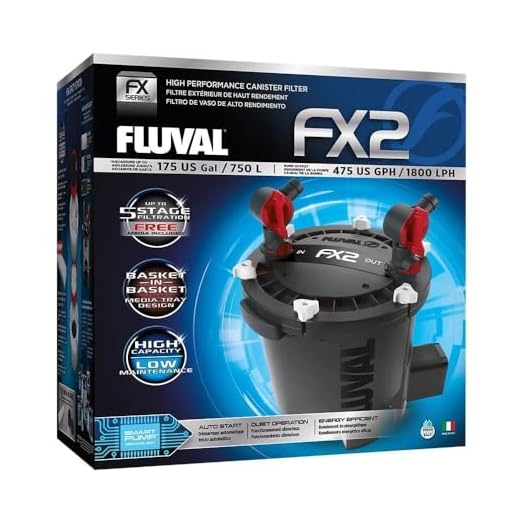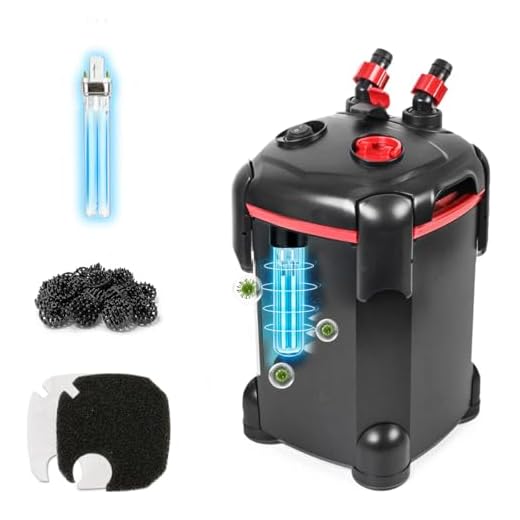Reef
Blog
How to set up aquarium filter pump

Setting up a filter pump is an essential step in keeping your aquarium clean and maintaining a healthy environment for your fish. The filter pump plays a crucial role in removing debris, waste, and harmful substances from the water, ensuring it remains clear and safe for your aquatic pets. Properly setting up a filter pump will not only enhance the aesthetic appeal of your aquarium but also promote the overall well-being of your fish.
Step 1: Choose the Right Filter Pump
Before setting up your filter pump, it’s important to select the right one for your aquarium. Factors such as the size of your tank, the type and number of fish, as well as the volume of water in your tank should all be considered. There are various types of filter pumps available, including air-driven sponge filters, hang-on-back filters, and canister filters. Research and choose the filter pump that best suits your aquarium’s needs.
Step 2: Prepare the Filter Pump
Once you have chosen the appropriate filter pump for your aquarium, it’s time to prepare it for installation. Start by thoroughly rinsing all filter media, such as foam pads or activated carbon, as per the manufacturer’s instructions. This helps remove any dust or debris that may have accumulated on the media. Additionally, make sure the impeller, which is responsible for pumping water, is free from any obstructions and running smoothly.
Step 3: Install the Filter Pump
Now that your filter pump is ready, it’s time to install it in your aquarium. Most filter pumps come with suction cups or hooks that can be attached to the side or back of the tank. Place the filter pump in the desired location, ensuring it is secure and stable. It is recommended to position the filter pump near the water surface to maximize oxygenation and water circulation. Remember to check that all necessary hoses or tubes are properly connected to the filter pump.
Tip: It’s important to follow the manufacturer’s instructions when installing your filter pump, as each brand may have specific requirements and recommendations.
Step 4: Prime the Filter Pump
Priming your filter pump is crucial to ensure effective operation. Priming refers to removing any air that may be trapped in the pump to allow proper water flow. Some filters have a built-in priming feature, while others require manual priming. Refer to the manufacturer’s instructions to determine the correct priming method for your filter pump. Once primed, the filter pump is ready to start removing impurities and maintaining a clean and healthy aquatic environment for your fish.
Aquarium Filter Pump Setup: A Step-by-Step Guide
Setting up a filter pump in your aquarium is crucial for maintaining a healthy environment for your fish. Follow these simple steps to properly set up your aquarium filter pump.
Step 1: Choose the Right Filter Pump
Before you begin the setup process, make sure you have the appropriate filter pump for your aquarium size. Consider factors such as the pump’s flow rate and the type of filtration it provides.
Step 2: Position the Filter Pump
Select a suitable location for your filter pump. Ideally, it should be near the aquarium, but not directly in the water. Ensure that the pump is stable and secure to avoid any accidents.
Step 3: Connect the Hoses
Attach one end of the hose to the pump outlet and the other end to the filter inlet. Make sure the connections are secure to prevent any leaks. You may need to trim the hose to the appropriate length.
Step 4: Install the Filter Media
Most filter pumps require filter media for effective filtration. Follow the manufacturer’s instructions to install the appropriate filter media, such as foam pads or activated carbon, into the filter housing.
Step 5: Prime the Pump
Fill the filter pump with water to prime it. This helps remove any air trapped in the system and ensures smooth operation. Follow the manufacturer’s instructions on how to properly prime the pump.
Step 6: Plug In and Test
Once the pump is primed, plug it into a power source. Observe the water flow and ensure it is steady and appropriate for your aquarium. Make adjustments if necessary.
Step 7: Monitor and Maintain
Regularly inspect and clean the filter pump to ensure it continues to function properly. Follow the manufacturer’s recommendations for maintenance and replace any worn-out parts if needed.
By following these steps, you can successfully set up your aquarium filter pump and create a clean and healthy environment for your fish.
Choosing the Right Filter Pump for Your Aquarium
When setting up an aquarium, choosing the right filter pump is crucial for maintaining a clean and healthy environment for your fish and other aquatic creatures. The filter pump plays a vital role in removing impurities from the water, ensuring that it remains clear and free of harmful chemicals.
Filtration Efficiency
One of the most important factors to consider when selecting a filter pump is its filtration efficiency. Different types of filter pumps offer varying degrees of filtration, so it’s crucial to understand the specific needs of your aquarium.
For smaller tanks or aquariums with a low bio-load, a simple sponge filter or hang-on-back (HOB) filter pump may be sufficient. These types of filter pumps provide basic mechanical and biological filtration, removing debris and waste from the water.
On the other hand, larger tanks or those with a high bio-load may require more advanced filtration systems, such as canister filters or wet/dry filters. These filter pumps offer a higher level of filtration, including mechanical, chemical, and biological filtration, ensuring that the water is crystal clear and free of harmful substances.
Tank Size and Flow Rate
The size of your aquarium is another crucial consideration when choosing a filter pump. The filter pump should have an adequate flow rate to ensure effective filtration throughout the entire tank.
As a general rule of thumb, the filter pump should be able to process the entire volume of water in your aquarium at least four times per hour. For example, if you have a 50-gallon tank, the filter pump should have a minimum flow rate of 200 gallons per hour.
Noise Level
Another factor to consider is the noise level of the filter pump. Some filter pumps can be quite loud, which can be disruptive and unpleasant, especially if the aquarium is placed in a living area or bedroom.
When selecting a filter pump, look for models that are designed to operate quietly. Many manufacturers offer filter pumps with noise reduction features, such as foam padding or rubber feet, which help to minimize vibrations and reduce noise.
Reliability and Maintenance
Lastly, consider the reliability and ease of maintenance of the filter pump. A reliable filter pump is essential for the overall health of your aquarium, as any malfunction or breakdown can quickly lead to a decline in water quality.
Choose a filter pump from a reputable manufacturer known for producing high-quality products. Additionally, look for filter pumps that are easy to disassemble and clean, as regular maintenance is essential to ensure optimal performance.
| Filter Pump Type | Filtration Efficiency | Tank Size | Flow Rate | Noise Level | Reliability |
|---|---|---|---|---|---|
| Sponge Filter/HOB Filter | Basic | Small | Dependent on model | Usually quiet | Average |
| Canister Filter/Wet-Dry Filter | Advanced | Large | Dependent on model | Possible noise depending on model | High |
Finding the Ideal Spot for the Filter Pump
Choosing the right location for your aquarium filter pump is crucial for maintaining a healthy and balanced aquatic environment. Here are some factors to consider when finding the ideal spot:
1. Proximity to the Aquarium
Place the filter pump as close to the aquarium as possible to ensure efficient water circulation and filtration. The closer the pump is to the tank, the better it can remove debris and keep the water clean.
2. Water Depth
Consider the depth of your aquarium when positioning the filter pump. Some pumps are designed for specific depths, so make sure to check the manufacturer’s recommendations. Placing the pump too close to the surface can result in excessive splashing, while positioning it too close to the bottom may hinder its performance.
3. Water Current
Observe the natural currents in your tank and position the filter pump to work with them. Aim for a gentle, steady flow that provides sufficient oxygenation and prevents stagnant areas. Avoid creating strong currents that may stress or disturb your aquatic organisms.
4. Accessibility
Place the filter pump in an easily accessible location for maintenance and cleaning. You will need to clean or replace the filter media regularly, so ensure that the pump is not obstructed by decorations or hard-to-reach areas.
5. Noise Level
Consider the noise level of the filter pump and its impact on your living space. Some pumps can be noisy, especially if they vibrate. Opt for a pump with a quiet operation or use noise-dampening materials to minimize any disturbances.
By carefully considering these factors, you can find the ideal spot for your aquarium filter pump, ensuring optimal water circulation and filtration for your aquatic pets.
“Question-Answer”
What is an aquarium filter pump?
An aquarium filter pump is a device used to circulate and filter water in an aquarium. It helps to remove debris, waste, and harmful substances from the water, ensuring a clean and healthy environment for the fish.
Why is it important to set up an aquarium filter pump?
Setting up an aquarium filter pump is important because it helps to maintain the water quality in the tank. The pump ensures proper circulation and filtration, removing waste and keeping the water oxygenated for the fish to breathe. It also prevents the growth of harmful bacteria and algae in the aquarium.
How do I set up an aquarium filter pump?
To set up an aquarium filter pump, first, choose a suitable location for the pump near the tank. Then, follow the manufacturer’s instructions to attach the pump to the aquarium. Connect the pump to a power source and make sure it is securely in place. Finally, adjust the flow rate and any other settings according to your aquarium’s needs.
What should I do if my aquarium filter pump is not working properly?
If your aquarium filter pump is not working properly, first check if it is properly connected to the power source. Make sure all the connections are secure and there are no loose parts. Clean the pump and filter media to remove any clogs or debris that may be affecting its performance. If the problem persists, consider contacting the manufacturer for further assistance or replacing the pump if necessary.





